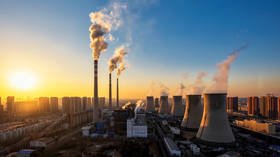China has just launched world's largest carbon market

For many years, China sacrificed environmental stewardship at the altar of economic growth, adopting a growth-at-all-costs strategy.
The economy-first mentality helped Beijing lift 850 million of its citizens from dire poverty but also made the country the biggest emitter of greenhouse gases.
However, that has been rapidly changing under president Xi Jinping who has vowed to adopt more stringent environmental policies as he seeks to temper the hardline stance that dominated previous administrations. Shortly after Xi Jinping's election in 2013, China introduced the "Green Fence" operation designed in part to improve the quality of the plastics waste coming into the country before following it up two years later with the "National Sword Campaign" that effectively banned the importation of plastics into the country.
Also on rt.com China rolls out carbon trading scheme in a bid to meet its ambitious 2060 neutrality goalLast year, the president reiterated his environmentally friendly stance after he announced that the country had set a firm goal to become carbon neutral by 2060.
And now China has just launched a nationwide carbon trading marketplace in what could become one of its most significant steps taken to lower GHG emissions and achieve its climate goals.
China, which accounts for 28 percent of the world's greenhouse gas emissions, has become the world's first major economy to launch a national carbon emissions trading market.
China's carbon market
Many countries across Europe, as well as some parts of the US, have implemented carbon markets that force companies to offset their carbon emissions by investing in green projects that neutralize their emissions.
Read more on Oilprice.com: Trading giant Gunvor: $60 could be the сeiling for oil prices
For now, China's emissions trading system will cover its extensive power industry, including ~2,000 power generation facilities, which represent about 30 percent of the nation's total emissions. However, over time, the platform will expand to encompass heavy industries like oil, gas, steel, aluminum, cement, and chemicals.
Though undoubtedly ambitious, questions are already being asked about China's new carbon marketplace. For instance, the government plans to allocate emissions allowances for free but will begin to auction allowances "at a future appropriate time". This kind of leeway suggests that Beijing is still wary of the effect that carbon pricing could have on profitability and economic growth.
Also on rt.com Climate change ‘key’ in Covid-19 spreading to humans – studyThat said, a survey of market participants indicates that prices are likely to start at around 41 yuan ($6.3) per ton of CO2, rising to 66 yuan per ton in 2025 and 77 yuan by 2030.
That's well below the $50 to $100 range by 2030 suggested by a commission on carbon prices formed in 2017 if the markets and prices are to have any impact on behavior.
Carbon offsets might not work
Though widely used by the developed economies, the efficacy of carbon offsets as a means to control climate change is increasingly being brought into question.
Scientists, activists, and concerned citizens have highlighted how companies are now using carbon offsets as a free pass for climate inaction. The types of carbon offset projects that are implemented are diverse, ranging from forestry sequestration projects to energy efficiency and renewable energy projects. The world needs to lower annual emissions by 29-32 gigatonnes of equivalent carbon dioxide (CO2e) by 2030 to have a fighting chance to stay below 1.5°C. That's ~5x the current commitments by companies, organizations, and governments. We need to lower our GHG emissions by 45 percentover the next decade if we are to avert catastrophic planetary changes.
Read more on Oilprice.com: US rig count jumps amid rising oil prices
The sad truth is that trees planted today simply can't grow fast enough to come anywhere near achieving this goal, and the majority of carbon offset projects will never be able to curb the emissions growth if coal power plants and gasoline vehicles continue to dominate.
UNEP has warned that the biggest risk posed by carbon credits is that they tend to encourage complacency. According to UN Environment climate specialist Niklas Hagelberg:
"UN Environment supports carbon offsets as a temporary measure leading up to 2030, and a tool for speeding up climate action. However, it is not a silver bullet, and the danger is that it can lead to complacency. The October 2018 report by the Inter-governmental Panel on Climate Change made it clear that if we are to have any hope of curbing global warming we need to transition away from carbon for good: by travelling electric, embracing renewable energy, eating less meat and wasting less food."
Also on rt.com ‘Biggest polluter in history’: China hits back at US criticism of its climate policy with reminder of Washington’s shortcomingsRenewable Energy Credits, or RECs, have been suggested as a better alternative to carbon offsets.
Whereas a carbon offset represents an action that effectively sequesters carbon, RECs are like a property deed representing a part of a renewable energy source, such as a solar or wind farm.
By buying RECs and pairing it with electricity from the grid, companies, and organizations directly support the development of renewable energy infrastructure. RECs provide access to alternative energy sources to areas that do not have the capacity to produce their own renewable energy.
This article was originally published on Oilprice.com













